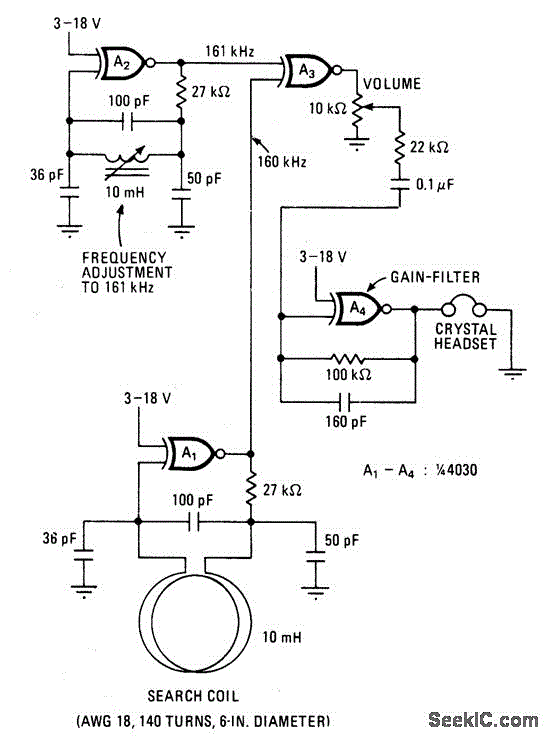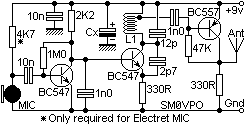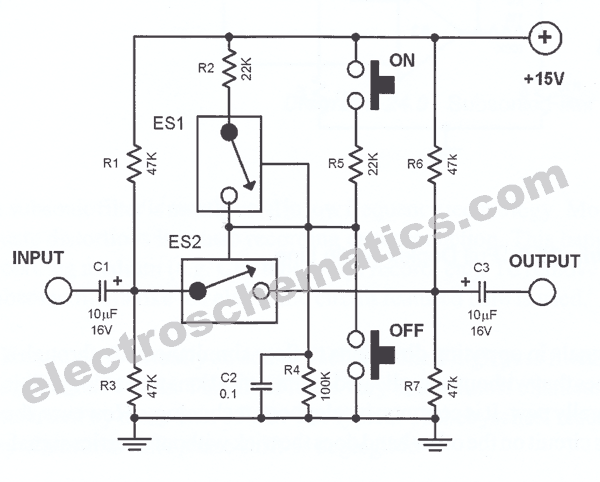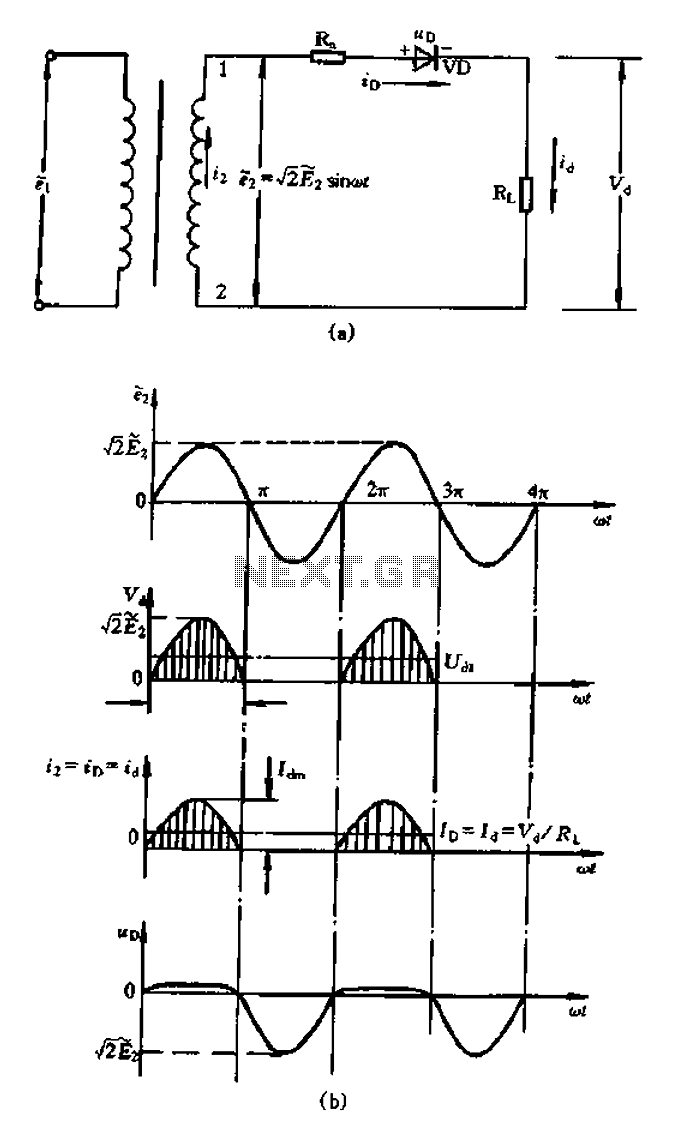
1000W AC power supply automatic voltage regulator circuit
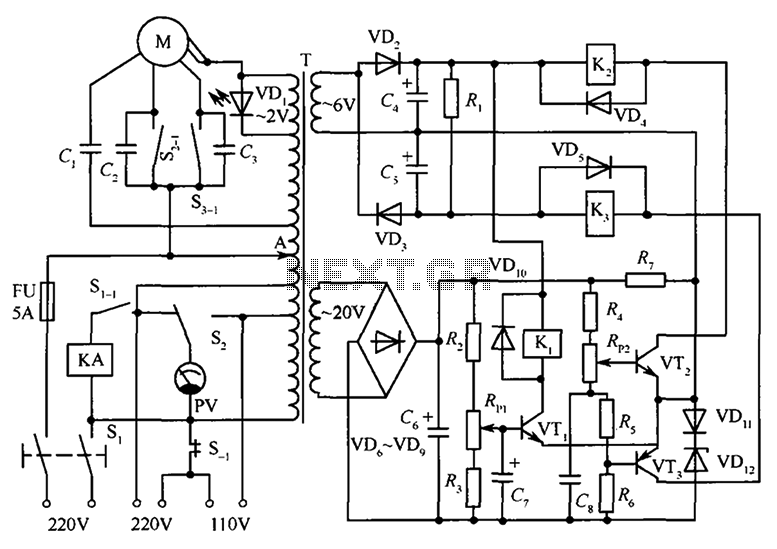
The circuit illustrated in the figure features an automatic voltage regulator (T) that utilizes a servo motor to ensure a constant output voltage. The transistors used are VT1 and VT2 (3DK9C, with a range of 65 to 85) and VT3 (3AX818, with a range of 60 to 80). The diodes include VD2, VD3, and VD6 through VD9 (1N4002), while VD4, VD5, and VD10 are 1N4148 diodes. VD11 is an IN4001 diode, and the light-emitting diode VD1 is a BT304. The Zener diode VD12 is a 2CW119. The capacitors consist of C1 (1 µF, 400V), C2 and C3 (0.1 µF, 250V), C4 and C5 (220 µF, 25V), C6 (470 µF, 50V), and C7 and C8 (47 µF, 50V). The resistances are R1 (10kΩ), R2 and R7 (510Ω), R3 and R6 (2.7kΩ), R4 (470Ω), and R5 (51Ω). The power resistors, particularly R1, should have a power rating exceeding 3W, while the others are rated between 1/2W and 1/4W and are preferably metal film resistors. The potentiometers are RPl and RP2 (1kΩ). The relays Kl through K3 are JRK-13F, and the AC contactor is KA (522). The servo motor is designated as M (ND-D), and the voltmeter PV is rated from 85L1-0 to 250V. The switches are S1 (KN3 3) and S2 (KN-2W1D), and the fuse is FU (BGOP µ6-5A).
The automatic voltage regulator circuit is designed to maintain a stable output voltage despite variations in input voltage or load conditions. The heart of this circuit is the servo motor that adjusts the output voltage dynamically. The transistors VT1, VT2, and VT3 form a part of the voltage regulation mechanism, where their characteristics are crucial for the proper functioning of the regulator. The choice of diodes, including 1N4002 and 1N4148, ensures that the circuit can handle the necessary voltage levels and provide adequate protection against reverse polarity.
Capacitors play a vital role in filtering and stabilizing the output voltage. The configuration of capacitors with varying capacitances allows for effective smoothing of the output waveform, which is essential for sensitive electronic applications. The selection of resistors, particularly the higher wattage for R1, indicates that this component will dissipate more heat under load, necessitating careful thermal management.
Potentiometers RPl and RP2 are used for fine-tuning the output voltage, providing flexibility in the circuit's operation. The relays (Kl through K3) are employed to control the switching of loads, ensuring that the circuit can manage different operational states effectively. The AC contactor (KA) is integrated to control higher power loads, demonstrating the circuit's capability to interface with various electrical devices.
Overall, the schematic represents a robust design that incorporates multiple components working in unison to achieve efficient voltage regulation, making it suitable for a wide range of applications in electronic systems. Proper attention to component ratings and configurations will enhance the reliability and performance of the voltage regulator circuit.As shown in FIG circuit, T is auto voltage regulator. Its output fixed input end by a servo motor to automatically adjust the output remains constant.Transistor VTl, VT2: 3DK9C, = 65 ~ 85; VT3: 3AX818, = 60 ~ 80; diode VD2, VD3, VD6 ~ VD9: 1N4002; VD4, VD5, VD10: 1N4148; VD11: IN4001; light-emitting diodes VD1: BT304; Zener diode VD12: 2CW119; capacitor C1: l F400V; C2, C3: 0.1 F250V; C4, C5: 220 F25V; C6: 470 F50V; C7, C8: 47 F50V; resistance Rl: 10k ; R2, R7: 510 ; R3, R6: 2.7k ; R4: 470 ; R5: 51 ; resistance in addition to the nominal power resistors Rl to select more than 3W power, other are selected 1/2 ~ 1 / 4W metal film resistors; potentiometer RPl, RP2: 1k ; relay Kl ~ K3: JRK-13F; AC contactor KA: 522; servo motor M: ND-D; voltmeter PV: 85L1-0 ~ 250V; switch S1KN3 3; S2: KN-2W1D; fuse FU: BGOP µ6-5A .
The automatic voltage regulator circuit is designed to maintain a stable output voltage despite variations in input voltage or load conditions. The heart of this circuit is the servo motor that adjusts the output voltage dynamically. The transistors VT1, VT2, and VT3 form a part of the voltage regulation mechanism, where their characteristics are crucial for the proper functioning of the regulator. The choice of diodes, including 1N4002 and 1N4148, ensures that the circuit can handle the necessary voltage levels and provide adequate protection against reverse polarity.
Capacitors play a vital role in filtering and stabilizing the output voltage. The configuration of capacitors with varying capacitances allows for effective smoothing of the output waveform, which is essential for sensitive electronic applications. The selection of resistors, particularly the higher wattage for R1, indicates that this component will dissipate more heat under load, necessitating careful thermal management.
Potentiometers RPl and RP2 are used for fine-tuning the output voltage, providing flexibility in the circuit's operation. The relays (Kl through K3) are employed to control the switching of loads, ensuring that the circuit can manage different operational states effectively. The AC contactor (KA) is integrated to control higher power loads, demonstrating the circuit's capability to interface with various electrical devices.
Overall, the schematic represents a robust design that incorporates multiple components working in unison to achieve efficient voltage regulation, making it suitable for a wide range of applications in electronic systems. Proper attention to component ratings and configurations will enhance the reliability and performance of the voltage regulator circuit.As shown in FIG circuit, T is auto voltage regulator. Its output fixed input end by a servo motor to automatically adjust the output remains constant.Transistor VTl, VT2: 3DK9C, = 65 ~ 85; VT3: 3AX818, = 60 ~ 80; diode VD2, VD3, VD6 ~ VD9: 1N4002; VD4, VD5, VD10: 1N4148; VD11: IN4001; light-emitting diodes VD1: BT304; Zener diode VD12: 2CW119; capacitor C1: l F400V; C2, C3: 0.1 F250V; C4, C5: 220 F25V; C6: 470 F50V; C7, C8: 47 F50V; resistance Rl: 10k ; R2, R7: 510 ; R3, R6: 2.7k ; R4: 470 ; R5: 51 ; resistance in addition to the nominal power resistors Rl to select more than 3W power, other are selected 1/2 ~ 1 / 4W metal film resistors; potentiometer RPl, RP2: 1k ; relay Kl ~ K3: JRK-13F; AC contactor KA: 522; servo motor M: ND-D; voltmeter PV: 85L1-0 ~ 250V; switch S1KN3 3; S2: KN-2W1D; fuse FU: BGOP µ6-5A .
